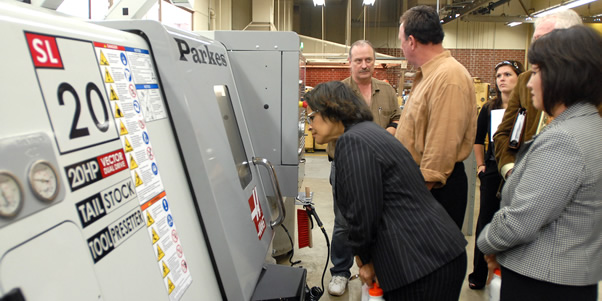Engineering Shows Off New Facilities
Building Design, Water Purity and Earthquake Safety Labs, Computerized Machine Shop Now Available
September 23, 2008
By Russ Hudson
The College of Engineering and Computer Science has swung open the doors to new labs and other facilities constructed last summer to improve opportunities for its majors.

How the weight and the incursion of water can affect different layers of soil can be tested in this large tank in the Soils Mechanics Laboratory being explained by Binod Tiwari, assistant professor of civil and environmental engineering. Photo by Kelly Lacefield
An open house Sept.10 allowed campus and community members to view state-of-the-art computer, electronics, design, operating systems and project labs, as well as the Alcoa Foundation Environmental Engineering Laboratory used to chemically assess water turbidity and to detect any chemical and bacterial contamination.
Among the projects on exhibit were large and small robots in various stages of development and, in a senior design lab, a Global Positioning Systems-guided lawn mower that needs no driver. In addition, thre was an automobile that the student Drift Club is redesigning to make controlled turns at very high speeds, as in the 2006 movie “The Fast and the Furious: Tokyo Drift.” Computer controls on the power train, suspension and/or braking system could be involved.
Tour visitors were able to see a new Soil Mechanics area where civil engineering students test factors that can affect building safety, such as the weight-bearing capacity of various soil types when wet, dry and under a load. That knowledge is crucial in keeping buildings upright and in place, even during earthquakes. The tests help determine how deep to make a foundation, whether pylons are needed and how tall and heavy a building can be, according to Binod Tiwari, assistant professor of civil and environmental engineering.
Next to the soils area is the Structures Lab, where items such as reinforced-concrete building columns can be subjected to the kinds of stresses that weight, use and earthquakes would inflict. The area includes a hydraulic compression-testing loading frame (a large hydraulic press) designed by Pinaki Chakrabarti, chair and professor of civil and environmental engineering, that can apply up to 1,000 kilos (1 million pounds) of pressure to the columns.
The machine shop has been transformed from an old-style, oil-can type of shop into a floor space with six state-of-the-art, enclosed computer-controlled production machines that can “look” at a computer-modeled image of a student-designed object and make it, sometimes in just a few minutes. The Parkes machines, contributed by Haas Automation Inc. in a deal specially negotiated for ECS, have greatly expanded what engineering students can do in their research and their projects … as has nearly everything at every stop on the tour, said ECS Dean Raman Unnikrishnan.


